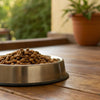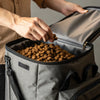How to Store Freeze-Dried Dog Food: Essential Tips for Freshness and Quality
- Houndsy
Table of Contents
- Introduction
- Understanding Freeze-Dried Dog Food
- Best Practices for Storing Freeze-Dried Dog Food
- Common Mistakes to Avoid
- Recognizing Spoilage
- Conclusion
Introduction
Did you know that properly stored freeze-dried dog food can remain nutritious and flavorful for years? This impressive shelf life makes freeze-dried options a popular choice among pet owners looking for high-quality nutrition without the hassle of refrigeration. However, to reap the benefits of freeze-dried dog food, we must understand the best practices for storage. In this guide, we will delve into how to store freeze-dried dog food effectively, ensuring that our furry friends enjoy every meal as intended.
As dog lovers, we know that the feeding ritual goes beyond simply providing food; it’s about nurturing our pets with the highest quality meals possible. With proper storage, we can keep our freeze-dried dog food fresh and maintain its nutritional value, enhancing our pets' overall well-being.
By the end of this article, we will have covered essential storage tips, common mistakes to avoid, and the science behind freeze-dried food preservation. Let’s embark on this journey together, reflecting on our own pet feeding routines and discovering how we can make them even better.
Understanding Freeze-Dried Dog Food
Before we explore storage methods, it’s essential to grasp what freeze-dried dog food is and why it requires specific care. Freeze-drying is a process that removes moisture from food while preserving its nutritional content. This method not only extends shelf life but also ensures that the food retains its flavor and essential nutrients.
Benefits of Freeze-Dried Dog Food
- Nutritional Integrity: Freeze-drying preserves more nutrients compared to traditional drying methods, making it a healthy choice for our pets.
- Long Shelf Life: When stored correctly, freeze-dried dog food can last for several years, providing a reliable food source.
- Convenience: It’s lightweight and easy to store, making it an excellent option for travel or emergency situations.
- Variety: Freeze-dried food can be rehydrated or served dry, offering versatility in feeding methods.
Why Proper Storage Matters
Even though freeze-dried food is shelf-stable, exposure to moisture, air, and light can negatively impact its quality. Proper storage is crucial to prevent spoilage and ensure that each meal we serve is as nutritious as possible.
Best Practices for Storing Freeze-Dried Dog Food
1. Keep It in Original Packaging
Most freeze-dried dog foods come in resealable bags designed to keep the contents fresh. These packages are typically made from materials that block light and moisture. Always reseal the bag tightly after each use to prevent air from entering. If the original packaging is damaged, transfer the food to an airtight container.
2. Use Airtight Containers
If you choose to transfer the food, opt for airtight containers made from durable materials like glass or high-quality plastic. These containers will protect the food from air and moisture, preventing spoilage and contamination. It may be beneficial to label the container with the date of purchase to track its freshness.
3. Store in a Cool, Dry Place
Humidity and heat can degrade freeze-dried food, causing it to lose its nutritional quality and taste. Find a cool, dry place in your home, such as a pantry or a dedicated storage cabinet, away from direct sunlight. Avoid areas that experience temperature fluctuations, like kitchens or garages.
4. Avoid the Refrigerator and Freezer
While it might seem logical to store freeze-dried dog food in the refrigerator or freezer, this can introduce moisture into the food, leading to spoilage. The best practice is to keep the food in a stable, room-temperature environment that’s dry and cool.
5. Use Within Recommended Timeframe
Even though freeze-dried dog food has a long shelf life, it’s best to use it within the recommended timeframe mentioned on the packaging. Generally, once opened, it’s advisable to consume the food within a few months to ensure maximum freshness and nutritional value.
6. Keep Away from Pests
Freeze-dried dog food can attract pests like rodents and insects if not stored properly. Ensure that the food is stored in a place that’s inaccessible to pests or use containers that are pest-proof. Regularly check the storage area for any signs of contamination.
7. Proper Handling
Always handle freeze-dried dog food with clean, dry hands or use a dedicated scoop to avoid introducing moisture or contaminants. This practice will help maintain the food's quality and prevent potential spoilage.
8. Consider Bulk Storage Wisely
For those of us who buy freeze-dried dog food in bulk, it’s essential to divide the food into smaller portions. Store the portions we won’t use immediately in a deep freezer to keep them fresh until needed. Using the first-in, first-out method will ensure we always feed our pets the freshest food available.
Common Mistakes to Avoid
While storing freeze-dried dog food may seem straightforward, there are common pitfalls that can lead to spoilage or loss of quality. Here are a few mistakes to be mindful of:
- Neglecting to Reseal: Failing to reseal the packaging after each use allows air and moisture to enter, which can lead to spoilage.
- Storing in Humid Areas: Placing freeze-dried food in areas prone to moisture, like basements or near sinks, can compromise its quality.
- Ignoring Expiration Dates: Always check the expiration date on the packaging to avoid feeding outdated food to our pets.
- Relying Solely on Original Packaging: While the original packaging is suitable for short-term storage, transferring the food to airtight containers may be necessary for long-term storage.
Recognizing Spoilage
Being vigilant about food quality is essential for our pets' health. Signs that freeze-dried dog food may be spoiled include:
- Off Smell: A rancid or musty odor can indicate that the food has degraded.
- Visible Mold: Any signs of mold growth should be taken seriously; discard the food immediately.
- Clumping or Dampness: If the food feels damp or clumpy, it may have been exposed to moisture and should be discarded.
Conclusion
In summary, understanding how to store freeze-dried dog food is vital for keeping our furry friends healthy and happy. By following the tips outlined in this article, we can ensure that each meal served is fresh, nutritious, and safe.
Proper storage not only enhances the feeding experience but also reflects our commitment to our pets' well-being. As we embrace the convenience and quality that freeze-dried dog food offers, let’s take these proactive steps to protect what matters most—our beloved companions.
So, why not take a moment to explore our flagship product, the Houndsy Kibble Dispenser? Designed for convenience and style, it makes feeding time a pleasure for both you and your dog. Order Now and elevate your dog feeding experience today!
Frequently Asked Questions
How long can I store freeze-dried dog food after opening the bag?
Once opened, it’s best to use freeze-dried dog food within 30 to 60 days for optimal freshness and nutritional value.
Can I store the food in its original packaging?
Yes, the original packaging is designed to keep the food fresh. Just ensure to reseal it tightly after each use.
What type of container is best if I want to transfer the food?
Airtight, opaque containers made from durable materials like glass or high-quality plastic are ideal to protect the food from light and moisture.
Is it safe to store freeze-dried dog food in a humid environment?
No, humidity can lead to spoilage. Store freeze-dried dog food in a cool, dry place.
How should I handle leftovers after rehydrating the food?
Leftover rehydrated food should be stored in a sealed container in the refrigerator and consumed within 48 hours. Avoid re-freezing rehydrated food.
Can I store freeze-dried dog food near a window or heat source?
No, direct sunlight and heat can degrade the nutrients in the food. Keep it in a dark, cool cupboard or pantry instead.
What should I do if the food feels damp or clumpy?
If the food feels damp or has clumps, it may have been exposed to moisture and should be discarded to ensure your pet's safety.
Is it okay to buy freeze-dried dog food in bulk?
Buying in bulk can be cost-effective, but ensure to store unused portions properly to maintain freshness, such as in a deep freezer.
How can I tell if freeze-dried dog food has gone bad?
Check for off smells, visible mold, or any changes in texture. Always inspect the food before serving.
By following these guidelines, we can ensure that our dogs enjoy the best of what freeze-dried food has to offer, keeping their tails wagging and their health thriving!













